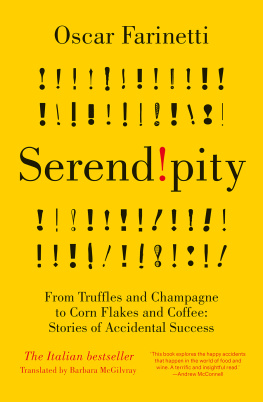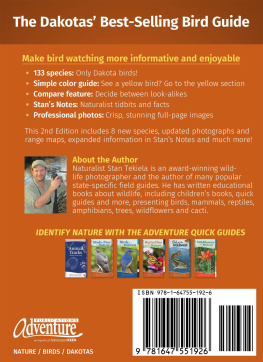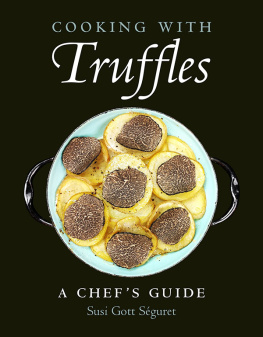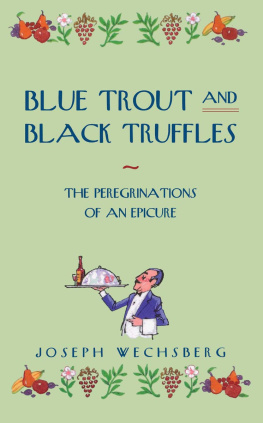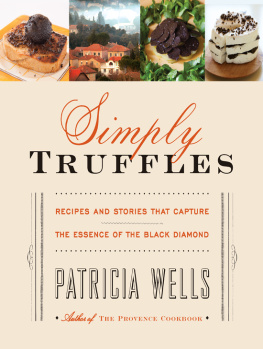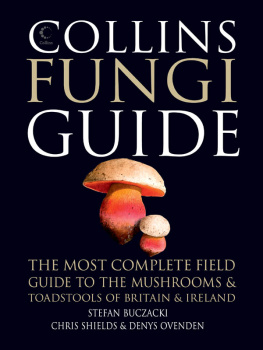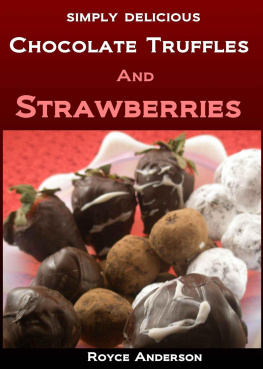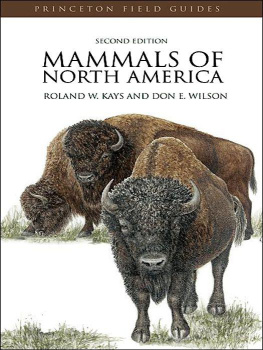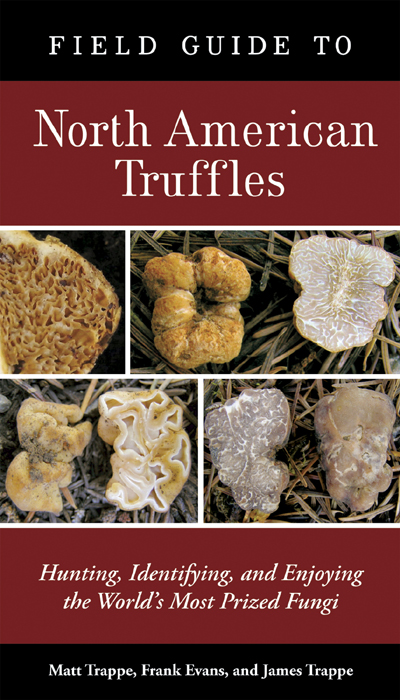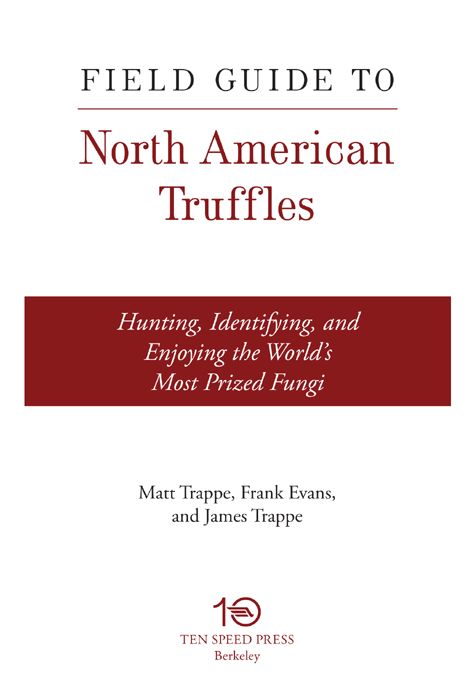The information in this book is accurate to the best of the authors knowledge. However, neither the authors nor the publisher can accept responsibility for mistakes in identification or idiosyncratic reactions to truffles or trufflelike fungi; people who eat fungi do so at their own risk.
Text and photography copyright 2007 by Matt Trappe, Frank Evans, and James Trappe.
All rights reserved. Published in the United States by Ten Speed Press, an imprint of the Crown Publishing Group, a division of Random House, Inc., New York.
www.crownpublishing.com
www.tenspeed.com
Ten Speed Press and the Ten Speed Press colophon are registered trademarks of Random House, Inc.
Library of Congress Cataloging-in-Publication Data
Trappe, Matt.
Field guide to North American truffles: hunting, identifying, and enjoying the worlds most prized fungi / Matt Trappe, Frank Evans, and James Trappe.
p. cm.
Summary: A full-color illustrated guide to identifying North American truffles by their key features; includes profiles and photographs of more than 80 species of truffles, as well as a delectability rating and culinary use tips for each species
Includes bibliographical references and index.
1. TrufflesNorth AmericaIdentification. 2. TrufflesNorth AmericaPictorial works. 3. Cookery (Truffles) I. Evans, Frank. II. Trappe, James M. III. Title.
QK617.T775 2007
579.57dc22
2007015864
eISBN: 978-0-307-80775-5
Cover and text design by Chloe Rawlins
All photographs by Matt Trappe, Frank Evans, and James Trappe unless otherwise indicated
v3.1
Acknowledgments
For many years, the North American Truffling Society (NATS) has made a packet of truffle photographs available to its members to assist them in their study of fungi that fruit belowground. In the process of updating the packet, the concept for this book was born. The information in this book derives from the earlier effort. We would like to acknowledge the long years of work by Pat Rawlinson, who duplicated the photos many times, and Vern Moore, who gathered and maintained the information sheets that accompanied that packet.
The beauty and much of the value of this book is in the photographs. The efforts of these photographers made it all possible: Mike Castellano, Todd Elliot, Jonathan Frank, Roy Halling, Susan Hopkins, Dave Largent, Charles Lefevre, Donna Mitchell, and Matt Smith. Mike Castellano and Efrn Czares reviewed the text and suggested many improvements. Much of the information on fresh characters and distribution of the various species was provided by members of the North American Truffling Society. All these contributions combined to make the book more comprehensive.
Thanks!
Contents
Introduction to Truffles
Truffles have long enjoyed a mysterious appeal, not only to the mycologist but also to a wider audience. These exotic fungi have been celebrated in myth and lore as well as being worshiped by chefs around the world. The Italian White (Tuber magnatum), the French Black (Tuber melanosporum), and the summer truffle (Tuber aestivum) are world famousthe great culinary truffles of the world. These truffles are only a few of the many underground fungi to be found. Collectors encounter hundreds of other species while searching beneath the forest floor. Indeed, the spring and fall Oregon White Truffles (Tuber gibbosum and Tuber oregonense, respectively) are considered by many to rank among the worlds great culinary delights. This book includes only a sampling of the hundreds of North American species. A few are indeed culinary delights, but most have only modest attractiveness for cooking. All, however, are interesting and important in our forest ecosystems.
Across North America, the temperate forest supports a wide range of fungal species. Within this diversity are many belowground-fruiting species. Until recently, this community of specially adapted fungi was known only to a few mycologists. The references available for study of these truffles are specialized or rare scientific books and papers. Only a few tangential references to truffles and trufflelike species exist in most popular mushroom books. This book is a first of its kind and will be of great help to all who are interested in these underground jewels.
What Are Truffles?
A truffle is the spore-bearing organ (fruit) of a fungus. The actual fungal organism is a perennial network of underground mycelium (fungal filaments dispersed in the soil). Unlike mushrooms, truffles develop entirely underground. Whereas mushrooms typically disperse their spores in the wind, truffles need the help of animals to spread their spores. Most truffles are consumed by forest animals that dig them up for food. It is no surprise that truffles have evolved to emit aromas that appeal to animals, often including humans. When mature, truffles produce these odor signals to effectively say eat me! The aromas develop only when at least some spores are mature, then intensify as more and more spores mature. Thus an animal is not likely to detect a specimen before many of its spores are ready, and it is not likely to miss a specimen in which all the spores are ready.
Truffle spores pass through the digestive system unharmed and are deposited in feces to germinate and form new fungal colonies, often great distances away from their parent. As a food source, they are an important part of forest ecosystems; some small mammals (such as certian voles) subsist almost entirely on truffles!
One defining characteristic of truffle-forming fungi is that nearly all form symbiotic relationships with plants. This is a mutually beneficial partnership in which the fungal mycelium and the root cells of the plant grow together creating special structures with the roots called mycorrhizae (from Greek, myco = fungus and rhiza = root). The plant shares the sugars it creates by photosynthesis with the fungus, and the fungus assists the tree roots to take up water, minerals, and other nutrients from the soil. The fungal mycelia are much more efficient than unaided tree roots at foraging for nutrients; as much as 100 meters of fungal hyphae (microscopic filaments of fungal cells) can be found in a single teaspoon of healthy forest soil!
This symbiotic relationship is so important that very few tree species can grow without their mycorrhizal fungi associates; many forest tree nurseries now intentionally inoculate seedlings that will be used in reforestation with mycorrhizal fungi. There are varying degrees of specificity in this symbiotic relationship; truffles are always found in association with particular plants, sometimes with only a single species of tree. Likewise, different trees have varying numbers of fungi with which they will form mycorrhizae.
In parts of Europe, the term truffle is used to refer to only certain kinds of belowground-fruiting fungi, sometimes only to species that are commercially harvested. In this field guide we use the term in a broader sense to designate all macroscopic fungi that fruit belowground. Most truffle species are related to or directly descended from aboveground mushroom-forming fungi, so it is no surprise that some belowground species look like compressed mushrooms. Some examples of the latter are included in this guidebook, for example, Gastroboletus, Macowanites, Rhopalogaster


